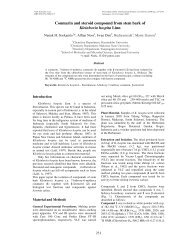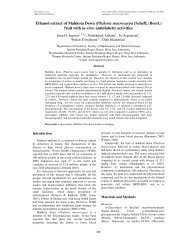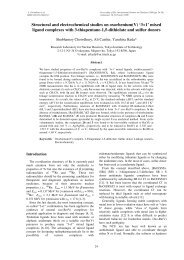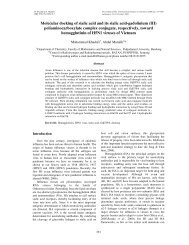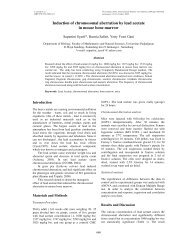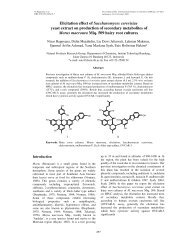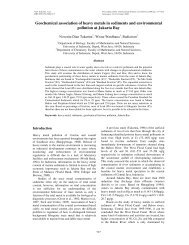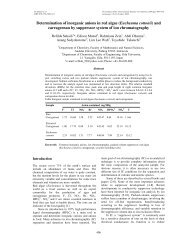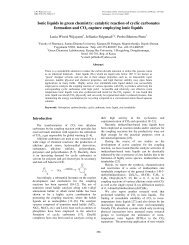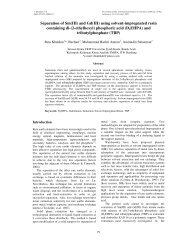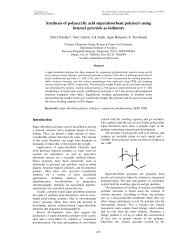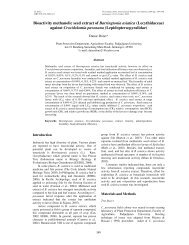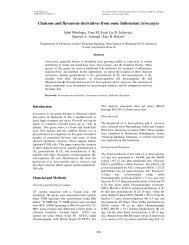Kinetics and morphology transformation of manganese oxide in acid ...
Kinetics and morphology transformation of manganese oxide in acid ...
Kinetics and morphology transformation of manganese oxide in acid ...
You also want an ePaper? Increase the reach of your titles
YUMPU automatically turns print PDFs into web optimized ePapers that Google loves.
D.K. Wal<strong>and</strong>a Proceed<strong>in</strong>g <strong>of</strong> The International Sem<strong>in</strong>ar on Chemistry 2008 (pp. 180-184)<br />
ISBN 978-979-18962-0-7<br />
Jat<strong>in</strong>angor, 30-31 October 2008<br />
<strong>K<strong>in</strong>etics</strong> <strong>and</strong> <strong>morphology</strong> <strong>transformation</strong> <strong>of</strong> <strong>manganese</strong> <strong>oxide</strong><br />
<strong>in</strong> <strong>acid</strong> electrolyte<br />
Daud K. Wal<strong>and</strong>a<br />
Department <strong>of</strong> Chemistry, FKIP-University <strong>of</strong> Tadulako, Palu 94118 - Indonesia<br />
e-mail: wal<strong>and</strong>a@gmail.com<br />
Abstract<br />
Manganese <strong>oxide</strong> such as Mn 2 O 3 has been widely used as start<strong>in</strong>g materials for the<br />
preparation <strong>of</strong> battery active MnO 2 . Digestion <strong>of</strong> lower valence <strong>manganese</strong> <strong>oxide</strong> (Mn 2 O 3 )<br />
<strong>in</strong> a range <strong>of</strong> H 2 SO 4 solutions at a variety <strong>of</strong> temperatures (20–80 °C) has led to the<br />
conversion <strong>of</strong> k<strong>in</strong>etically stable <strong>manganese</strong> di<strong>oxide</strong> samples. The k<strong>in</strong>etic <strong>transformation</strong> <strong>of</strong><br />
Mn 2 O 3 <strong>in</strong>to <strong>manganese</strong> di<strong>oxide</strong> (MnO 2 ) <strong>in</strong> sulphuric <strong>acid</strong> has been studied. It is assumed<br />
that the conversion <strong>of</strong> Mn 2 O 3 <strong>in</strong>to MnO 2 is a first order autocatalytic reaction. The<br />
<strong>transformation</strong> actually proceeds through olation–oxolation process via a dissolutionprecipitation<br />
mechanism <strong>in</strong>volv<strong>in</strong>g disproportionation <strong>of</strong> a soluble Mn(III) <strong>in</strong>termediate. In<br />
this reaction Mn 2 O 3 whose structure sp<strong>in</strong>el type, which is pack<strong>in</strong>g between tetrahedral<br />
coord<strong>in</strong>ation <strong>and</strong> octahedral coord<strong>in</strong>ation, is converted to form octahedral tunnel structure<br />
<strong>of</strong> <strong>manganese</strong> di<strong>oxide</strong>, which is probably regarded as a reconstructive octahedralcoord<strong>in</strong>ation<br />
<strong>transformation</strong>. Morphology <strong>of</strong> the products confirmed that different phase <strong>of</strong><br />
<strong>manganese</strong> di<strong>oxide</strong> are detected. Therefore, it is a desire to <strong>in</strong>vestigate the <strong>transformation</strong> <strong>of</strong><br />
<strong>manganese</strong> <strong>oxide</strong>s <strong>in</strong> solid state chemistry by analys<strong>in</strong>g XRD powder patterns. Due to the<br />
reactions <strong>in</strong>volv<strong>in</strong>g solids, concentration <strong>of</strong> reactant <strong>and</strong> product are approached with the<br />
expression <strong>of</strong> peak areas.<br />
Keywords: <strong>K<strong>in</strong>etics</strong>, <strong>morphology</strong>, <strong>manganese</strong> <strong>oxide</strong>, <strong>acid</strong> electrolyte, <strong>transformation</strong><br />
Introduction<br />
The <strong>manganese</strong> <strong>oxide</strong> <strong>transformation</strong> <strong>in</strong> sulphuric<br />
<strong>acid</strong> has been a subject <strong>of</strong> study by several groups<br />
such as Gorichev et al. (Ashakura, 1976; Gorichev,<br />
1979; Pankratova, 2001) who studied the k<strong>in</strong>etic<br />
disproportionation <strong>of</strong> <strong>manganese</strong>(III) <strong>oxide</strong>; further,<br />
Ozhuku et al. (1984) <strong>and</strong> Kao et al. (Kao, 1987; Kao,<br />
1989) <strong>in</strong>vestigated the phase <strong>in</strong>terconversion <strong>of</strong><br />
<strong>manganese</strong> di<strong>oxide</strong> from γ- <strong>in</strong>to β- phase. These<br />
k<strong>in</strong>etic studies have been monitored directly from<br />
solution us<strong>in</strong>g either spectrophotometric or<br />
photocolorimetric methods. Laudy <strong>and</strong> De Wolff<br />
(1963), however, have performed a γ/β-MnO 2<br />
<strong>transformation</strong> study <strong>in</strong> the solid state us<strong>in</strong>g a method<br />
<strong>in</strong>volv<strong>in</strong>g exam<strong>in</strong>ation <strong>of</strong> the relative frequency p <strong>of</strong><br />
pyrolusite layers for a number <strong>of</strong> <strong>manganese</strong> di<strong>oxide</strong><br />
samples at temperatures up to 480 o C.<br />
The digestion variables <strong>of</strong> <strong>acid</strong> concentration <strong>and</strong><br />
temperature play a significant role <strong>in</strong> determ<strong>in</strong><strong>in</strong>g the<br />
MnO 2 phase produced; i.e., γ, α or β, as well as<br />
comb<strong>in</strong>ations <strong>of</strong> each, through the solubility <strong>of</strong> the<br />
Mn(III) <strong>in</strong>termediate <strong>and</strong> the mechanism <strong>of</strong> its<br />
disproportionation. The k<strong>in</strong>etics <strong>of</strong> this digestion<br />
process has been reported to be first order (Purol,<br />
1968; Purol 1975). To study this process further we<br />
have used powder X-ray diffraction as a means to<br />
exam<strong>in</strong>e the k<strong>in</strong>etics <strong>of</strong> the conversion.<br />
The k<strong>in</strong>etic <strong>transformation</strong> <strong>of</strong> Mn 2 O 3 <strong>in</strong>to<br />
<strong>manganese</strong> di<strong>oxide</strong> has been regarded by us as an<br />
autocatalytic first order reaction. As <strong>in</strong> Eqn(1), it<br />
might found that the rate law for the reaction, as<br />
concentration <strong>of</strong> reactant <strong>and</strong> product are expressed as<br />
a mole fraction, is<br />
v = k(X A )(X B ) (1)<br />
where k is the rate constant <strong>and</strong> X A <strong>and</strong> X B are the<br />
mole fractions <strong>of</strong> Mn 2 O 3 <strong>and</strong> MnO 2 , respectively. If x<br />
is the extent <strong>of</strong> reaction then the rate equation<br />
becomes:<br />
dx<br />
= k(X<br />
A<br />
- x)(X<br />
B<br />
+ x)<br />
(2)<br />
dt<br />
Integration <strong>of</strong> this equation gives<br />
1 (X<br />
B<br />
+ x)X<br />
A<br />
ln<br />
= kt (3)<br />
X + X X (X - x)<br />
A<br />
B<br />
B<br />
or solved for x, gives<br />
k(XA<br />
+ XB<br />
)t<br />
X<br />
B(<br />
e -1)<br />
x =<br />
(4)<br />
X<br />
B k(XA<br />
+ XB<br />
)t<br />
1+<br />
e<br />
X<br />
A<br />
S<strong>in</strong>ce X A + X B = 1, <strong>and</strong> if b = X B /X A , the reaction can<br />
be simplified, hence<br />
A<br />
180
D.K. Wal<strong>and</strong>a Proceed<strong>in</strong>g <strong>of</strong> The International Sem<strong>in</strong>ar on Chemistry 2008 (pp. 180-184)<br />
Jat<strong>in</strong>angor, 30-31 October 2008<br />
x<br />
X ( e -1)<br />
1+<br />
be<br />
kt<br />
=<br />
B<br />
kt<br />
(5)<br />
The b value for different <strong>acid</strong> concentration is<br />
given <strong>in</strong> Figure 1(a). Us<strong>in</strong>g the above equation fitted<br />
on the k<strong>in</strong>etic data, it should exhibit an ‘S-shape’ or<br />
sigmoid curve pr<strong>of</strong>ile. The pr<strong>of</strong>ile is characteristic <strong>of</strong><br />
an autocatalytic reaction. This is <strong>in</strong> agreement with the<br />
work done by Brenet et al. (1968) Figure 1(b) shows a<br />
typical autocatalytic curves for MnO 2 formation <strong>and</strong><br />
Mn 2 O 3 disappearance.<br />
Materials <strong>and</strong> Methods<br />
Synthesis<br />
The start<strong>in</strong>g materials Mn 2 O 3 was prepared by<br />
heat<strong>in</strong>g EMD <strong>in</strong> a furnace at 550 o C for 24 hours, after<br />
which time it was spectroscopically pure. The reaction<br />
that occurred <strong>in</strong> this process was:<br />
2MnO 2 Mn 2 O 3 + ½O 2 (6)<br />
A k<strong>in</strong>etic study <strong>of</strong> Mn 2 O 3 decomposition was<br />
conducted by which 10 g <strong>of</strong> Mn 2 O 3 was digested <strong>in</strong><br />
sulphuric <strong>acid</strong> with concentrations <strong>of</strong> either 0.5, 1.0 or<br />
2.0M.<br />
X-Ray Diffraction Analysis<br />
X-ray diffraction analysis <strong>of</strong> each sample was<br />
conducted at room temperature us<strong>in</strong>g a Philips 1710<br />
diffractometer with Cu Kα radiation <strong>of</strong> wavelength<br />
1.5891 Å. The <strong>in</strong>strumental conditions that were<br />
employed as follows:<br />
(a) X-ray generator sett<strong>in</strong>gs <strong>of</strong> 40 kV <strong>and</strong> 30 mA.<br />
(b) A scan range <strong>of</strong> 10 – 80 o 2θ<br />
(c) A step size <strong>of</strong> 0.05 o 2θ every 2.5 seconds<br />
(d) A divergence slit width <strong>of</strong> 1 o<br />
(e) A receiv<strong>in</strong>g slit 0.1 mm<br />
Samples were mounted by a backfill<strong>in</strong>g procedure <strong>in</strong><br />
flat alum<strong>in</strong>ium holders.<br />
Peak Parameters<br />
The k<strong>in</strong>etics <strong>of</strong> Mn 2 O 3 <strong>transformation</strong> <strong>in</strong>to MnO 2 was<br />
studied us<strong>in</strong>g X-ray diffraction. Data result<strong>in</strong>g from<br />
the XRD analysis was treated <strong>in</strong> the follow<strong>in</strong>g way:<br />
(a) Parameter Determ<strong>in</strong>ation: From the full XRD<br />
patterns, selected ranges were exam<strong>in</strong>ed where<br />
suitable peaks from either Mn 2 O 3 or MnO 2 were<br />
present; i.e., 19-26 o , 32-34 o , 37-39 o , 54-58 o o 2θ. The<br />
peaks <strong>in</strong> these 2θ ranges were then modelled us<strong>in</strong>g a<br />
Lorentzian l<strong>in</strong>eshape (Donne, 1996):<br />
2<br />
W<br />
I = I<br />
(7)<br />
MAX 2 2<br />
4[(W/2) + (X - µ ) ]<br />
(b) Area Determ<strong>in</strong>ation: From the optimised peak<br />
parameters the area <strong>of</strong> each <strong>in</strong>dividual peak was<br />
determ<strong>in</strong>ed by numerical <strong>in</strong>tegration.<br />
(c) Peak Normalisation: The average peak area<br />
for Mn 2 O 3 (23.1°, 32.9°, <strong>and</strong> 55.1° 2θ) <strong>and</strong> MnO 2<br />
(21.9° <strong>and</strong> 37.0° 2θ) was then converted to a mole<br />
fraction (X) know<strong>in</strong>g the average peak areas before<br />
(Mn 2 O 3 ) <strong>and</strong> after (MnO 2 ) conversion had occurred.<br />
In this work, the mole fraction can be def<strong>in</strong>ed as the<br />
ratio <strong>of</strong> the average <strong>of</strong> peak area at time t, (A t ) to the<br />
maximum peak area, (A max ) <strong>of</strong> each species <strong>of</strong> <strong>in</strong>terest,<br />
either Mn 2 O 3 or γ-MnO 2 .<br />
Results <strong>and</strong> Discussion<br />
Effect <strong>of</strong> Acid Concentration<br />
As shown <strong>in</strong> Figure 2(a), the k<strong>in</strong>etic rate <strong>of</strong> MnO 2<br />
formation is generally <strong>in</strong>creased as both <strong>acid</strong><br />
concentration <strong>and</strong> temperature are <strong>in</strong>creased.<br />
However, once the temperature reaches 100 o C <strong>and</strong><br />
above, the k<strong>in</strong>etics <strong>of</strong> the <strong>manganese</strong> di<strong>oxide</strong><br />
formation is not mean<strong>in</strong>gful due to all the product then<br />
produced be<strong>in</strong>g β-MnO 2 (pyrolusite) <strong>in</strong>stead <strong>of</strong> γ-<br />
MnO 2 ; thus the data presented has been limited to a<br />
maximum <strong>of</strong> 80 o C.<br />
Accord<strong>in</strong>gly, this would support an <strong>in</strong>crease <strong>in</strong><br />
reaction rate as a function <strong>of</strong> <strong>acid</strong> concentration. The<br />
variation <strong>in</strong> observed rate with <strong>acid</strong> concentration is<br />
not a simple (e.g., l<strong>in</strong>ear) relationship, imply<strong>in</strong>g that a<br />
fairly complex mechanism is <strong>in</strong>volved.<br />
As expected, the rate constant <strong>of</strong> the tied process<br />
<strong>of</strong> Mn 2 O 3 disappearance is similarly dependent on the<br />
<strong>acid</strong> concentration <strong>and</strong> tempearture. Figure 2(b) shows<br />
the effect <strong>of</strong> <strong>acid</strong> concentration <strong>and</strong> temperature on the<br />
Mn 2 O 3 disappearance. The rate <strong>of</strong> MnO 2 formation is<br />
slighly smaller compared to the Mn 2 O 3 disappearance<br />
reaction rates, which suggest that there is an <strong>in</strong>itiation<br />
period at the beg<strong>in</strong>n<strong>in</strong>g <strong>of</strong> the reaction needed <strong>in</strong> order<br />
to form MnO 2 . This <strong>in</strong>itial period <strong>in</strong> which the<br />
reaction rate is reduced is called the <strong>in</strong>duction period,<br />
<strong>and</strong> is <strong>of</strong>ten clearly seen <strong>in</strong> autocatalytic processes.<br />
The process here is probably <strong>in</strong>volves nucleation<br />
reactions.<br />
The slowest step <strong>of</strong> a reaction that <strong>in</strong>volves<br />
several steps will act as the rate determ<strong>in</strong><strong>in</strong>g step. The<br />
conversion <strong>of</strong> Mn 2 O 3 <strong>in</strong>volves two processes i.e.<br />
dissolution <strong>and</strong> disproportionation, where the first<br />
reaction is ma<strong>in</strong>ly govern<strong>in</strong>g Mn 2 O 3 disappearance<br />
<strong>and</strong> the latter is <strong>in</strong>volved <strong>in</strong> MnO 2 formation. Here,<br />
with the latter apparently the slower overall process, it<br />
is assumed that the disproportionation <strong>of</strong> Mn(III) <strong>in</strong>to<br />
Mn(IV) <strong>and</strong> Mn(II) <strong>in</strong> electrolyte would be the rate<br />
determ<strong>in</strong><strong>in</strong>g step. Acidity <strong>of</strong> the Mn 3+ aq or its shortlived<br />
Mn 4+ aq analogue prior to its deprotonation <strong>and</strong><br />
water dissociation to form MnO 2 provides a basic for<br />
<strong>acid</strong> dependence <strong>of</strong> the reaction if either is a key<br />
<strong>in</strong>termediate <strong>in</strong> the rate determ<strong>in</strong><strong>in</strong>g step.<br />
181
D.K. Wal<strong>and</strong>a Proceed<strong>in</strong>g <strong>of</strong> The International Sem<strong>in</strong>ar on Chemistry 2008 (pp. 180-184)<br />
Jat<strong>in</strong>angor, 30-31 October 2008<br />
1.0<br />
0.8<br />
Mole Fraction<br />
0.6<br />
0.4<br />
0.2<br />
0.0<br />
0 10 20 30 40<br />
Time (h)<br />
1.0<br />
MnO 2 Formation<br />
0.8<br />
(a)<br />
Mole Fraction<br />
0.6<br />
0.4<br />
0.2<br />
0.0<br />
0 20 40 60 80 100<br />
Time (h)<br />
Mn 2 O 3 Disappearance<br />
(b)<br />
Figure 1 (a) Autocatalytic curves for MnO 2 formation as a function <strong>of</strong> time <strong>in</strong> different [H 2 SO 4 ] with various b<br />
value: (─●─) 0.5M <strong>and</strong> b= 9.98; (–▲─) 0.7M <strong>and</strong> b = 18.86; (─♦─) 1.0M <strong>and</strong> b = 11.66 <strong>and</strong> (─■─)<br />
2.0M <strong>and</strong> b = 8.52 <strong>and</strong> (b) autocatalytic reaction curves for MnO 2 formation <strong>and</strong> Mn 2 O 3<br />
disappearance.<br />
Effect <strong>of</strong> Temperature<br />
The temperature dependence <strong>of</strong> the rate constant<br />
was <strong>in</strong>vestigated at room temperature, 40, 60, 80 <strong>and</strong><br />
100 o C. Aga<strong>in</strong>, as can be seen <strong>in</strong> Figure 2, the rate<br />
constant <strong>of</strong> both formation <strong>and</strong> diappearance reactions<br />
is <strong>in</strong>creased as the temperature <strong>in</strong>creased. The basic<br />
equation relat<strong>in</strong>g the k<strong>in</strong>etic rate constant <strong>and</strong><br />
temperature is the Arrhenius equation (Laidler, 1995):<br />
k = A exp(– E a /RT) (8)<br />
where k is the rate constant, A is a pre-exponential<br />
factor, E a is the activation energy, R the universal gas<br />
constant <strong>and</strong> T the absolute temperature.<br />
From the equation above, the rate constant plotted<br />
aga<strong>in</strong>st various 1/T values gives the activation energy,<br />
with values determ<strong>in</strong>ed <strong>in</strong> this study given <strong>in</strong> Table 1.<br />
Values reported have errors<br />
<strong>of</strong> ±3 kJ mol –1 . With<strong>in</strong> error, activation parameters<br />
determ<strong>in</strong>ed for follow<strong>in</strong>g the reaction <strong>in</strong> each direction<br />
(disappearance <strong>and</strong> formation) are the same, as one<br />
would expect. A trend with vary<strong>in</strong>g <strong>acid</strong> concentration<br />
is not obvious, although at least up to 1.0 M <strong>acid</strong> the<br />
activation energy roughly decreases with <strong>in</strong>creas<strong>in</strong>g<br />
<strong>acid</strong>, essentially as expected if the reaction rate<br />
<strong>in</strong>creases as a function <strong>of</strong> <strong>acid</strong> concentration. For a<br />
complex reaction, E a may be a composite term, from<br />
which little mechanistically useful <strong>in</strong>formation can be<br />
obta<strong>in</strong>ed.<br />
Morphology <strong>of</strong> Transformation Products<br />
Figures 3(a)-(d) show SEM images <strong>of</strong> Mn 2 O 3 as a<br />
start<strong>in</strong>g material digested <strong>in</strong> 1.0 M H 2 SO 4 at 100 o C<br />
<strong>and</strong> aged at different times. The images clearly present<br />
the <strong>transformation</strong> <strong>of</strong> the start<strong>in</strong>g material with respect<br />
to reaction time. The <strong>morphology</strong> <strong>in</strong> Figure 3(a)<br />
belongs to a sample which is characterised as a<br />
mixture between Mn 2 O 3 <strong>and</strong> γ-MnO 2 . This<br />
<strong>morphology</strong> is nearly the same as the start<strong>in</strong>g<br />
material.As the digestion proceeds for longer periods,<br />
the start<strong>in</strong>g material is almost completely converted<br />
182
D.K. Wal<strong>and</strong>a Proceed<strong>in</strong>g <strong>of</strong> The International Sem<strong>in</strong>ar on Chemistry 2008 (pp. 180-184)<br />
Jat<strong>in</strong>angor, 30-31 October 2008<br />
<strong>in</strong>to <strong>manganese</strong> di<strong>oxide</strong>, however; another phase <strong>of</strong><br />
<strong>manganese</strong> di<strong>oxide</strong>, β-MnO 2 , also beg<strong>in</strong>s to appear.<br />
These <strong>transformation</strong>s will most likely end up with the<br />
more thermodynamically stable β-MnO 2 , which can<br />
be characterised by more needles form<strong>in</strong>g <strong>in</strong> the<br />
product with longer reaction times (Figure 3(d)).<br />
Figure 4 shows a cross-section <strong>of</strong> <strong>in</strong>dividual<br />
gra<strong>in</strong>s dur<strong>in</strong>g digestion, captured by polish<strong>in</strong>g down<br />
an epoxy-trapped sample. It shows a clear timedependent<br />
change with<strong>in</strong> the gra<strong>in</strong>s. It is obvious that<br />
the <strong>in</strong>terior <strong>of</strong> the start<strong>in</strong>g material particles is more<br />
compact with narrow furrows. After digestion <strong>in</strong> <strong>acid</strong><br />
at specified temperature, the particles are apparently<br />
less dense, which corresponds to the diffusion <strong>of</strong> <strong>acid</strong><br />
<strong>in</strong>to the <strong>in</strong>terior <strong>of</strong> particles <strong>and</strong> needles <strong>of</strong> product<br />
form around <strong>and</strong> with<strong>in</strong> channels <strong>of</strong> gra<strong>in</strong>s. The<br />
concentration <strong>of</strong> change at the surface supports a<br />
dissolution-reprecipitation mechanism.<br />
Table 1 Activation energies <strong>of</strong> Mn 2 O 3 disappearance<br />
<strong>and</strong> MnO 2 formation.<br />
[H 2 SO 4 ]<br />
(M)<br />
Mn 2 O 3<br />
Disappearance<br />
E a (kJ mol –1 )<br />
MnO 2<br />
Formation<br />
E a (kJ mol –1 )<br />
0.5 34.4 34.8<br />
0.7 27.2 23.0<br />
1.0 30.6 25.7<br />
2.0 45.3 50.2<br />
3.5<br />
3.0<br />
3.5<br />
3.0<br />
Rate Constant (h -1 )<br />
2.5<br />
2.0<br />
1.5<br />
1.0<br />
0.5<br />
0.0<br />
0.5<br />
0.7<br />
1<br />
[H 2 SO 4 ](M)<br />
2<br />
20<br />
40<br />
80<br />
60<br />
T( o C)<br />
Rate Constant (h -1 )<br />
2.5<br />
2.0<br />
1.5<br />
1.0<br />
0.5<br />
0.0<br />
0.5<br />
0.7<br />
[H 2 SO 4 ](M)<br />
1<br />
2<br />
20<br />
40<br />
80<br />
60<br />
T( o C)<br />
(a)<br />
(b)<br />
Figure 2 The effect <strong>of</strong> [H 2 SO 4 ] <strong>and</strong> temperature on k<strong>in</strong>etic rate constant on (a) the Mn 2 O 3 disappearance <strong>and</strong> (b)<br />
the MnO 2 formation.<br />
(a) (b) (c)<br />
Figure 3 SEM images <strong>of</strong> Mn 2 O 3 digested at 100 o C <strong>and</strong> at various times (a) 6 hours, (b) 12 hours, (c) 24 hours.<br />
183
D.K. Wal<strong>and</strong>a Proceed<strong>in</strong>g <strong>of</strong> The International Sem<strong>in</strong>ar on Chemistry 2008 (pp. 180-184)<br />
Jat<strong>in</strong>angor, 30-31 October 2008<br />
(a) (b) (c)<br />
Figure 4 Cross-section SEM images <strong>of</strong> samples that dispersed on epoxy: (a) Mn 2 O 3 ; (b) Mn 2 O 3 digested <strong>in</strong> 0.7M<br />
H 2 SO 4 at 100 o C for 24 hours; <strong>and</strong> (c) Mn 2 O 3 digested <strong>in</strong> 0.7M H 2 SO 4 at 100 o C for 2 days.<br />
Conclusions<br />
Utilis<strong>in</strong>g XRD data (mole fraction us<strong>in</strong>g peak<br />
area) as the basis for the k<strong>in</strong>etic study <strong>of</strong> Mn 2 O 3<br />
<strong>transformation</strong> <strong>in</strong>to <strong>manganese</strong> di<strong>oxide</strong>, an<br />
autocatalytic first order model has been employed<br />
successfully. The k<strong>in</strong>etic rate <strong>of</strong> both Mn 2 O 3<br />
disappearance <strong>and</strong> MnO 2 formation <strong>in</strong>creased as the<br />
<strong>acid</strong> concentration <strong>and</strong> temperature were<br />
<strong>in</strong>crementally <strong>in</strong>creased. However, the rate <strong>of</strong> MnO 2<br />
formation is somewhat smaller compared to that <strong>of</strong> the<br />
Mn 2 O 3 disappearance. This may be associated with<br />
the nucleation mechanism operat<strong>in</strong>g <strong>in</strong> the <strong>in</strong>duction<br />
period dur<strong>in</strong>g <strong>acid</strong> digestion.<br />
Acknowledgements<br />
I would like to acknowledge Dr. Scott W. Donne<br />
for the opportunity to work with him <strong>and</strong> his<br />
<strong>in</strong>troduction <strong>in</strong> connection with battery system <strong>in</strong> my<br />
academic experience.<br />
References<br />
Ashkharua, F. G., I. G. Gorichev, & N. G.<br />
Klyuchnikov. 1976. <strong>K<strong>in</strong>etics</strong> <strong>of</strong> the<br />
disproportionation <strong>of</strong> <strong>manganese</strong>(III) <strong>oxide</strong> <strong>in</strong><br />
sulfuric <strong>acid</strong>. Zh. Fiz. Khim. 50: 1707.<br />
Brenet, J., H. Purol, & A. Nowacki. 1968. Effects <strong>of</strong><br />
condition <strong>of</strong> preparation <strong>of</strong> <strong>manganese</strong> sesqui<strong>oxide</strong><br />
on the k<strong>in</strong>etics <strong>of</strong> dismutation <strong>in</strong>to MnO 2 with high<br />
electrochemical activity. C.R. Acad. Sci., Paris Ser<br />
C. 267: 1749.<br />
Donne, S. W. 1996. PhD Thesis, High Performance<br />
Chemically <strong>and</strong> Physically Modified Manganese<br />
Di<strong>oxide</strong>. Newcastle University, Newcastle,<br />
Australia.<br />
Gorichev, I. G., L. V. Malov, & F. Ashkharua. G.,<br />
1979. <strong>K<strong>in</strong>etics</strong> <strong>of</strong> the disproportionation <strong>of</strong><br />
<strong>manganese</strong>(III) <strong>oxide</strong> <strong>in</strong> sulfuric <strong>acid</strong>. K<strong>in</strong>etika i<br />
Kataliz. 20: 67.<br />
Kao, W. H., C. W. Gross, & R. J. Ekern. 1987. J.<br />
Phase <strong>transformation</strong> <strong>of</strong> gamma-EMD to beta<br />
<strong>manganese</strong> di<strong>oxide</strong> dur<strong>in</strong>g digestion <strong>in</strong> sulfuric<br />
<strong>acid</strong>. Electrochem. Soc. 134: 1321.<br />
Kao, W.-H. 1989. The role <strong>of</strong> the <strong>acid</strong>ic electrolyte <strong>in</strong><br />
the phase <strong>transformation</strong> <strong>of</strong> gamma-EMD to beta<strong>manganese</strong><br />
di<strong>oxide</strong>. J. Electrochem. Soc., 136: 13.<br />
Laidler, K. J. & J. H. Meiser. 1995. Physical<br />
Chemistry, Houghton Miffl<strong>in</strong> Co., Boston,.<br />
Laudy, J. H. A. & P. M. De Wolff. 1963. X-ray<br />
<strong>in</strong>vestigation <strong>of</strong> the γ–β <strong>transformation</strong> <strong>of</strong> MnO 2 .<br />
Appl. Sci. Sec. B. 10: 157.<br />
Ohzuku, T., H. Higashimura, & T. Hirai. 1984. XRD<br />
Studies on the conversion from several <strong>manganese</strong><br />
<strong>oxide</strong>s to [beta]-<strong>manganese</strong> di<strong>oxide</strong> dur<strong>in</strong>g <strong>acid</strong><br />
digestion <strong>in</strong> MnSO 4 –H 2 SO 4 system. Electrochim.<br />
Acta. 29: 779.<br />
Pankratova, A. B., E. Y. Nevskaya, A. M. Kutepov, I.<br />
G. Gorichev, A. D. Izotov, & B. E. Zaitsev. 2001.<br />
Dissolution k<strong>in</strong>etics <strong>of</strong> <strong>manganese</strong>(III, IV) <strong>oxide</strong>s<br />
<strong>in</strong> sulfuric <strong>acid</strong> <strong>in</strong> the presence <strong>of</strong><br />
ethylenediam<strong>in</strong>etetraacetic <strong>acid</strong>. Theor. Found.<br />
Chem. Eng. 35: 168.<br />
Purol, H. 1975. Reaction k<strong>in</strong>etics <strong>of</strong> <strong>manganese</strong>(III)<br />
<strong>oxide</strong> with sulphuric <strong>acid</strong>. Przem. Chem. 54: 345.<br />
Purol, H., A. Nowacki, & J. Brenet, 1968. <strong>K<strong>in</strong>etics</strong> <strong>of</strong><br />
the disproport<strong>in</strong>ation <strong>of</strong> manganic <strong>oxide</strong> to<br />
<strong>manganese</strong> di<strong>oxide</strong> oh high electrochemical<br />
reactivity. C.R. Acad. Sci., Paris Ser C. 267: 429.<br />
184



